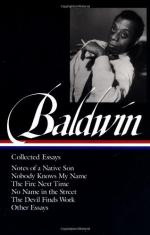|
This section contains 491 words (approx. 2 pages at 400 words per page) |

|
Notes of a Native Son Summary & Study Guide Description
Notes of a Native Son Summary & Study Guide includes comprehensive information and analysis to help you understand the book. This study guide contains the following sections:
This detailed literature summary also contains Topics for Discussion on Notes of a Native Son by James Baldwin.
The essays that comprise Notes of a Native Son range over many genres. Some are essentially memoirs, as in the case of the title essay, “Notes of a Native Son,” in which Baldwin reflects at length on his relationship with his father. In other essays, Baldwin wears the hat of the critic. “Carmen Jones: The Dark is Light Enough” is a film analysis, while “Everybody’s Protest Novel” and “Many Thousands Gone” are examples of literary criticism.
What all the essays share is incisive cultural analysis. Whether he is talking about the unreality of a film that is supposed to portray the African American experience or telling an anecdote about seeing his father on his deathbed, Baldwin is always making a larger point about American society and the American psyche. Baldwin has been compared to the biblical prophets, who stood at a remove from their society in order to rebuke and reform it. Baldwin’s prophetic quality is not to be confused, however, with the social activism of those who stand up for a cause. He insists again and again that the role of the artist is not to champion causes but to express his own experience, which is the only thing he knows intimately enough to speak about with any honesty and insight. And though Baldwin owes something in his style and basic stance to the biblical prophets, his relationship to religion was neither simple nor positive. He saw Christianity, in which he grew up, as a mechanism by which African Americans channeled their desire for revenge against white oppressors, and he suggests in these essays that the Christian story is a legend serving to reinforce the hatreds and presuppositions of the people who told that story, much as the fictional account of a fight in a hotel lobby sets off a violent mob in Harlem, described in the essay “Notes of a Native Son.”
The book is divided into three parts. The first consists of three critical essays: one about the protest novel, generally, and Harriet Beecher Stowe’s Uncle Tom’s Cabin specifically; another about Richard Wright’s Native Son, and the last about the film, Carmen Jones. The second part of the book is the most journalistic and anecdotal. It consists of an essay about the Harlem ghetto, another about the trip of a group of African American musicians to Atlanta with the Progressive Party, and the last is the title essay about Baldwin’s relationship with his father. The third part of the book consists of four essays dealing with questions of identity that arose in a new way for Baldwin during his time abroad.
Notes of a Native Son was published in 1955 and therefore uses the term “Negro,” which was standard among both black and white Americans at the time, to refer to African Americans. In this summary the term “Negro” will occasionally be used, as it was the term Baldwin himself used.
Read more from the Study Guide
|
This section contains 491 words (approx. 2 pages at 400 words per page) |

|



